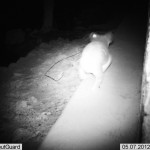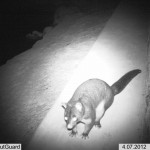Griffith University researchers have found that koalas are more clever than they thought them to be in a world-first study that tracked the Australian animal more comprehensively than ever before in suburban Brisbane.
The Environmental Futures Research Institute team, made up of Cathryn Dexter, Justin Scott and Professor Darryl Jones, at Griffith verified 130 crossings by koalas involving a retrofitted structure or eco-passage over a 30-month period.
The findings were released in a paper titled Using complementary remote detection methods for retrofitted eco-passages: a case study for monitoring individual koalas in south-east Queensland published by the CSIRO on Tuesday (July 26).
Professor Darryl Jones said nobody knew whether the structures would actually keep koalas safe from being hit by cars or if they would work.
 “We expected the animals to take a while to get used to them,” he said.
“We expected the animals to take a while to get used to them,” he said.
“To our great surprise they were using them three weeks into it. Can you teach koalas new tricks? You can, that’s the point. I was the first sceptical person to say they’re not that smart.”
The team used a range of technologies that allowed them to not just generically monitor whether koalas passed through the crossing but pinpointed individual koalas and the exact time they entered and left the tunnel.
Using camera traps, audio radio transmitters, RFID tags (similar to microchips in pets) and WIDs (wireless ID tags) – which act like RFID tags but can be detected from a much greater distance – they gathered more information than any previous research.
The WIDs weredeveloped by two Griffith graduates Rob Appleby and Jason Edgar who now run their own wildlife monitoring company, Wild Spy, and were a part of the research.
 “This is all about trying to make absolutely sure that koalas are using some of the structures we’ve put out for them to get safely under roads,” Professor Jones said.
“This is all about trying to make absolutely sure that koalas are using some of the structures we’ve put out for them to get safely under roads,” Professor Jones said.
“Knowing how they do that is really difficult. You can get photos but you don’t know if it’s the same animal each time.
“The essence of this you can get really import information using a range of technologies at the same time. That’s a world first. Nobody has done that so comprehensively before.
“We really wanted to know what individual koalas were doing, whether they crossed at the same time each day. We wanted more information than most people ever need and we did that using this range of technologies.”
Professor Jones said most people living in suburban Brisbane or parts of the Gold Coast did not realise koalas lived all around them and that these structures were keeping them safe in their backyards and off the roads.
The research was supported by funding from the Queensland Department of Transport and Main Roads, which was responsible for the structures.
 “The tunnels were an experiment,” Professor Jones said.
“The tunnels were an experiment,” Professor Jones said.
“Nobody knew whether they would work or not. We really wanted to know what the local koala was doing so we got ridiculous amount of details of these animals.
“We needed to be clear on whether they were successful because the structures were so innovative and risky that we tried really hard to prove it. That’s why it was worth it.
“Although we don’t want the koalas to be disturbed, all over the place on the Gold Coast and in Brisbane there are special koala specific tunnels and ledges that are allowing them to cross. Those animals are not going to be hit anymore so that’s good news.
The crossings studied in Brisbane were within the jurisdictions of Brisbane City, Redland City and Moreton Bay Regional Council.
Traffic volumes for this region are predicted to increase by 19 per cent, or 2.8 million trips per day between 2006 and 2031.
 The paper states: “The continuous clearing of koala habitat for development has placed a great deal of pressure on local koala populations and the risk of vehicle strike is recognised as a key threatening process for ongoing koala persistence in this region.
The paper states: “The continuous clearing of koala habitat for development has placed a great deal of pressure on local koala populations and the risk of vehicle strike is recognised as a key threatening process for ongoing koala persistence in this region.
“The focus must shift from studies that simply assess how many species pass through an eco-passage (i.e. presence), to those that assess the utilisation level by individuals.
“Such information will represent a powerful step forward in providing road authorities with recommendations in relation to the design and placement of crossing structures, and ensuring that the costs equal the ecological benefit.”
The paper can be found herehttp://www.publish.csiro.au/view/journals/dsp_journal_fulltext.cfm?nid=144&f=WR15153
